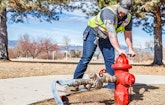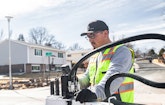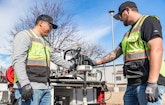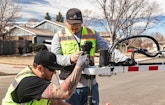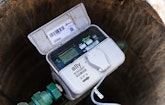
Distribution maintenance foreman Mark Uhland remotely analyzes data using the Xylem Sensus Pressure Profile software.
Interested in Infrastructure?
Get Infrastructure articles, news and videos right in your inbox! Sign up now.
Infrastructure + Get AlertsThe city of Westminster, Colorado, is a vibrant, growing city along the Denver-Boulder corridor. Like many cities across the country, Westminster is faced with managing aging distribution infrastructure.
The challenges of aging infrastructure require innovative approaches to becoming a more reliable and efficient service provider while making the most of existing infrastructure, and doing so as cost-effectively as possible. Replacing infrastructure with new assets is not always fiscally or operationally feasible.
The distribution system includes approximately 550 miles of waterlines, 15,955 isolation valves, 4,840 hydrant valves, and 10 pressure zones. The city also has 10 storage tanks with a total storage capacity of 31 million gallons.
Westminster’s primary source of water is Standley Lake, and its potable water demand ranges from 10 mgd in the winter to 44 mgd in the summer. The city has two drinking water treatment facilities. The Semper plant has a rated capacity of 44 mgd and the Northwest plant has a rated capacity of 15 mgd.
To become a more reliable and efficient service provider, the city has been an active participant in the American Water Works Association’s Partnership for Safe Water drinking water optimization program sponsored by AWWA, the U.S. Environmental Protection Agency and other organizations to recognize water suppliers that continuously go above and beyond regulatory requirements to provide high-quality drinking water through treatment plant and distribution system optimization.
Westminster’s distribution team has been an active participant since 2017 and received the Phase III Directors Award for the Distribution System Optimization Program in 2018. The team is currently working toward becoming one of the very few utilities in the country to achieve the Phase IV Presidents Award, which is an important milestone in continuous distribution system performance and operational improvement.
Culture of empowerment
Maintaining existing infrastructure may begin with equipment and materials, but it’s also about empowering people. Over the past 70 years, the city has taken successive steps to provide a reliable and safe water supply, manage growth and adapt to changing needs by developing a culture of teamwork among the city’s public works and utilities staff. That culture is essential in attracting and retaining great employees.
The distribution team is known for fostering a caring, team-oriented working environment with a commitment to excellence. Westminster’s work culture encourages innovation and creativity. The clear goal is to provide core services and foster economic resilience to give their community the opportunity to thrive.
Asset management
The city has been actively addressing water main breaks and overall distribution system health through a proactive water main replacement program. The distribution construction team, established in 1985, currently replaces 2 to 3 miles of primarily residential mains per year. This main replacement program was accelerated in the early 2000s to counteract increasing break rates within the distribution system. The program has been successful, with break rates steadily dropping from approximately 33 water main failures per 100 miles of pipe in 1996 to around seven failures per 100 miles in 2021.
“The in-house construction team has proven to be very nimble and helps save costs when needed,” says Water Distribution Superintendent Roger Harshman.
A few years ago, the city planned to remove several pressure reducing valves and vaults at an estimated cost of $350,000 to $400,000. Instead of contracting the project out, the construction team was deployed and they completed the project at a fraction of the cost.
“Not only do we replace water mains, we help our meter team rebuild meters, along with replacing vaults and valves,” says distribution construction team foreman Matt Bueno, who has worked in the utility for 17 years.
In 2014, the city hired a consultant to conduct an analysis aimed at optimizing and prioritizing water main rehabilitation and replacement. “This project has allowed appropriate prioritization of work, and it has given a schedule and roadmap for the city to replace top priority water mains at the right responsible moment,” Harshman says. “We are focusing on the pipes with the highest risk condition score or on stretches of pipe that have broken several times.”
In 2018, Westminster implemented the Cityworks asset management platform to help focus maintenance and capital spending on priority assets and areas. The distribution maintenance team is responsible for a variety of specialized work activities from valve maintenance and inspections to hydrant repair and flushing. The team is able to enter data in their trucks and make important decisions in real time by accessing Cityworks on their tablets.
“Cityworks is a powerful tool our team uses to leverage information to make informed decisions about whether to repair, renew, replace or allow assets to run to failure,” Harshman says. “They are staying on top of things through state-of-the-art technology and in-house skills, which allow more data-driven decisions to be made.”
Better metering
Gone are the days of customers waiting two months for a bill to find high water usage or waiting for city staff to drive to homes and read customers’ meters or check for leaks. From 1992 to 2020, the department relied on a drive-by automatic meter reading system that was a big step up from reading each meter individually. “It took one person 10 days a month to read all the meters,” says Brad Bettale, meter shop and cross-connection control foreman.
Westminster recently invested $14 million in new advanced metering infrastructure to replace over 30,000 residential and small commercial water meters. The new meters have reduced maintenance costs and improved customer service by giving customers more timely information about their water usage, including automatic leak notifications. These leak notices allow customers to find and fix leaks before they receive a high bill. By replacing outdated meters, the city also reduced labor and equipment costs associated with meter reading and maintenance.
“Switching over more recently to an advanced metering infrastructure, we have increased the efficiency of the process, simplified the data collection work and saved staff time,” Bettale says.
One utility
The city’s public works and utilities department is comprised of four divisions (utilities operations, streets operations, water resource and quality, and utilities engineering) and the business operations group that maintain and enhance the safety and well-being of the community by providing water and wastewater service as well as maintaining the extensive network of street infrastructure. Westminster’s public works and utilities department adopts a “one utility” ethos that fosters collaborative planning between teams.
The utilities operations division operates and maintains the city’s waterlines, 25 miles of reclaimed waterlines, 23 miles of raw waterlines, 420 miles of sanitary sewer lines, 10 water storage facilities, two water treatment facilities, one reclaimed water treatment facility and one wastewater treatment facility. The operations division coordinates water and sewer system improvement projects and programs. It also administers the maintenance/asset management program that provides the public works and utilities department the resources needed to effectively maintain the many assets customers use on a daily basis.
The utility operations division, which includes the water distribution and wastewater collections teams, works closely with the streets operations division to coordinate street surface and subsurface construction work, such as waterline replacement, to maximize efficiencies and lower maintenance costs. The streets operations division provides overall maintenance of streets, manages annual street improvement projects, traffic control devices, stormwater drainage, street sweeping, and snow and ice control.
“They have a lot of streets they need to rehab and we work efficiently to coordinate fixing waterlines on the streets they work on. So, we prioritize and determine which lines we should focus on,” Bueno says.
Both the streets division and the utilities operations division work together to take into consideration the most critical needs of the distribution team in planning its work schedule.
“The collaboration is great. They’ll shift the scheduling of their street rehabilitation projects around to where we need to do water main repairs,” Bueno says.
Willingness to learn
Westminster’s utilities operations division takes pride in its employees’ education and opportunities to become state-certified water professionals. Harshman credits his team’s commitment to training and staying up to date on the latest industry certifications for their success.
“The city encourages professional society involvement and sends staff to external trainings and conferences,” he says. “The willingness to learn also comes with a willingness of staff to take responsibility for the system’s performance.”
Harshman says managing water distribution today requires a higher skill set, with more instrumentation and controls, data and stringent regulations for system compliance.
When the Colorado Department of Health and Environment came out with stricter backflow protection requirements, for example, distribution staff provided not only training for internal employees but also educated residents and now verifies certification for cross-connection installers and testers. Cross training is also encouraged throughout the utility’s various teams and helps strengthen the one utility concept.
Response network
The city believes that regional collaboration is a valuable approach for sharing knowledge, technology innovations and helping other utilities respond in times of emergency. Westminster is a part of Colorado’s Water/Wastewater Agency Response Network (CoWARN), which connects utilities to communities during an emergency when water or wastewater services are interrupted by natural or manmade disasters.
When Lyons, Colorado, a small city 35 miles northwest of Westminster, was inundated with a 100-year flood in 2015, Westminster’s water distribution team helped locate waterlines and leaks. When Paonia couldn’t keep water in its tank, two members of the team traveled 230 miles to the western Colorado town to pinpoint leaks using its Gutermann leak detection equipment.
More recently, when the Marshall Fire hit the communities of Superior and Louisville, they had to bypass their water treatment plant and send untreated water to fight the fire, which resulted in a boil order. “To bring the system back online, they had to do extensive flushing of the lines,” says Mark Uhland, distribution maintenance team foreman.
Eight Westminster team members joined other community departments in the flushing effort. “They thought it would take them two weeks to get it back. We did it in only two days,” Uhland says.
Helping other communities is part of Westminster’s culture, and Harshman says it’s mutually beneficial. It helps build knowledge, reliability and resilience. “We all talk to other utilities and network and are here for them. It is our responsibility to help others be better. We’re all in this together.”




